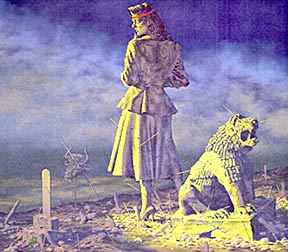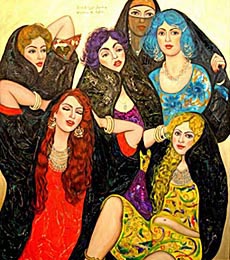An Iraqi artist paints Donald Rumsfeld
The Iraqi surrealist painter, Muayad Muhsin, has painted a rather unflattering portrait of U.S. Defense Secretary, Donald H. Rumsfeld. Muhsin’s surrealism is not informed by dreams and the unconsciousness mind, but by the horrors and barbarity of war. His painting titled, Picnic, portrays a combat boot wearing Rumsfeld relaxing comfortably in a chair, his raised feet resting on a destroyed relic from Iraq’s Babylonian past. In the background can be seen a giant fractured statue of a lion standing triumphantly over a vanquished man – another motif from ancient Babylon. The statue’s based is smashed open, and out of it white papers are flying up into the sky – a metaphor not only for the country’s past but for the looted libraries and art museums destroyed in the opening days of America’s blitzkrieg shock and awe bombing and invasion.

Like many other Iraqi artists, Muayad Muhsin (41) was press ganged into Saddam’s army, and he’s a veteran of Iraq’s wars against Iran and Kuwait. He despises the former dictator for having taking “the best years of my life.” While it’s true Iraqi artists feel relief at Saddam being removed from power, they also seem to have little fondness for those who’ve proclaimed themselves liberators.
As Mushin says, “The Americans brought us rosy dreams but left us with nightmares, they came with a broad smile but gave us beheaded bodies and booby-trapped cars.”
The wit and wisdom of U.S. Defense Secretary Donald Rumsfeld has not been lost on the Iraqi people, he certainly is a quotable fellow, and it is Rumsfeld’s drollness that in part inspired Muhsin’s painting. When America launched its shock and awe attack to supposedly disarm Iraq of its weapons of mass destruction, Rumsfeld famously said of those WMD’s, “We know where they are. They’re in the area around Tikrit and Baghdad and east, west, south and north somewhat.” The Associated Press reports that the surrealist painter has harsh words for Rumsfeld and the Americans, “They did not find weapons and instead, found the annals of an ancient civilization that turned into birds of love, peace and knowledge. Rumsfeld’s boots deliver a message from America: ‘We rule the world.’” Muhsin makes clear the intent of his painting, “It speaks of America’s total indifference to what the rest of the world thinks” and symbolizes “America’s soulless might and arrogance.” As a further act of resistance, the artist signed his painting in the middle instead of the conventional bottom corner – so as to avoid having his signature under Rumsfeld’s boots.

On a related note, Muayad Muhsin is mentioned in an overview of contemporary Iraqi art, written by artist Steve Mumford for artnet.com in 2003. Mumford’s article focused on the artists associated with Baghdad’s famous Hewar Gallery just as the guerrilla war against the U.S. occupation began to expand. Mumford arrived in Iraq after American troops seized Baghdad, and he was “embedded” with the U.S. Army’s Third Infantry Division as a combat artist. He rode upon one of the unit’s armored personnel carriers, and by his own admission, “when the battle was going on, I stayed below in the armored personnel carrier and passed up ammunition” – which have led some to remark that Mumford was “in bed with” the U.S. occupation forces. Still, Mumford’s outline of the current art scene in Iraq is worth reading as a basic primer, and the examples of paintings by Iraqi artists that illustrate the article are particularly enlightening. However, much has changed in Iraq in three years, and if Muayad Muhsin’s latest painting is any indication – the U.S. has almost run out of friends in that country.

